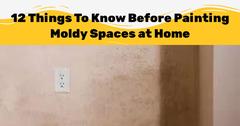Blog Post
12 Things To Know Before Painting Moldy Spaces at Home

Apart from being unsightly, mold can become a health concern if left to grow inside a home.
While some people attempting to solve the mold problem resort to painting over moldy areas, this solution often hides the problem instead of getting rid of it.
In fact, if you cannot control the mold before painting, the problem could get worse. Thus, it is crucial to find what caused the mold before you paint moldy surfaces.
But how do I deal with mold when painting? This is the question we want to focus on in this article.
However, we believe that to answer this question fully, we need to provide a comprehensive understanding of mold, why it is growing in your home, the health problems it can cause, how you can stop it before it becomes a catastrophe, and how you can prepare moldy walls before you paint.
What Is Mold?
If you have ever opened your bread bin to get a quick slice of bread and noticed that the bread is starting to have white or greenish cottony fuzz, you know what mold is. However, bread is not the only place where mold loves to grow. Bathrooms, kitchens, basements, and laundry rooms are other common places where you will find mold.
The American online publisher of human health and well-being news and information, WebMD.com, defines mold as “a type of fungus that consists of small organisms found almost everywhere.” Adding, “They can be black, white, orange, green, or purple.”
Scientists generally agree that molds have an important role in the environment. For instance, the United States Environmental Protection Agency (EPA) says, “Outdoors, molds play a part in nature by breaking down dead organic matter such as fallen leaves, dead trees, and other debris.”
Even though mold has an important role in the outdoors, it should not be allowed to thrive indoors.
Why Is Mold Growing in Your Home?
If you carefully check the parts of your home where you see visible mold, you will soon realize that those spaces have high moisture levels. This is the reason many people struggle with mold in the bathroom and basements.
The Centers for Disease Control and Prevention (CDC) says that “Mold will grow in places with a lot of moisture, such as around leaks in roofs, windows, or pipes, or where there has been flooding.” The same source adds, “Mold grows well on paper products, cardboard, ceiling tiles, and wood products.”
But how does mold get inside the home? It can be carried in the air and enter the home through openings like windows and doors. Mold can also be transmitted indoors attached to clothes and shoes. Once indoors, mold spreads by reproducing tiny cells known as spores.
Read Also : How Do You Paint a Wall Like A Pro? (5-Step Guide)
How Do You Know That You Have a Mold Problem?
As a part of nature, molds are everywhere, even though not always visible. This means that humans and molds can safely live side by side. However, too much of anything is not good, including molds.
Mold becomes a problem when you start to see it. You have a mold problem when you start to see dark spots on the walls or ceilings. You also know that you have a mold problem when people in your home start to show symptoms of mold allergies.
Molds Can Cause Health Problems
Moldy spaces are not just ugly; they could also make you and your family sick. The CDC says that “Exposure to damp and moldy environments may cause a variety of health effects, or none at all.” Adding that, “People with allergies may be more sensitive to molds.”
The Federal Emergency Management Agency reports that health challenges often begin when large quantities of mold and bacteria build-up, and people inhale them. However, the same agency notes that certain groups like infants, children, immune-compromised patients, pregnant women, individuals with existing respiratory conditions, and the elderly are at higher risk of molds’ adverse health effects.
Green Home Solutions, experts in mold, disinfection, odor, and allergen control, list some common symptoms of mold allergies:
- Coughing
- Sneezing
- Sore, itchy throat
- Congestion and runny nose
- Sinus headaches
- Wheezing and difficulty breathing
- Itchy, watery eyes
- Irritated, itchy skin
Nip Mold in the Bud
If you don’t want to have a mold catastrophe in your home, you will need to ensure that mold doesn’t accumulate to dangerous levels in the first place. This is a view supported by Jamie Kim, who writes for GoodHousekeeping.com, a Hearst Lifestyle Group-owned women’s interest magazine.
In her article, Kim writes, “Finding those black spots of mold in your shower or basement can be alarming.” But, “You’ll want to tackle the mold while it’s a small area because if left untouched, it can spread to a larger area.” This is because when left to spread, mold can ruin valuables, apart from making people sick.
We have more tips toward the end of this article about how you can ensure that mold doesn’t spread in your home.
Painting Moldy Spaces
For some, the easy way to get rid of visible molds involves making their way to the hardware store for a set of gloves, some brushes, and a tin of paint. The paint will certainly hide the mold for some time, but it will not eliminate the problem. This means that you will need to do a lot more before you apply a coat of paint.
Read Also: How To Dispose Of Paint? (3-Step Guide)
Removing the Mold First
Before getting to the hardware to find your painting supplies for moldy spaces, you will need to find stuff to remove mold first.
Katie Flannery writes for BobVila.com, a home advice website. In answer to a reader’s question about whether they can paint over mold they found in the bedroom, she says, “Painting over mold may cover up the dark patches where the mold is growing, but it will not eliminate the problem.”
Wear Protective Clothing
If you want to remove mold, you will need to ensure that you wear protective equipment, including gloves, a respirator mask, and eye protection.
EPA.gov suggests that the protective clothing you will need when removing mold depends on how much mold you are dealing with. For example, if you’re cleaning a small space, less than 10 square feet total, you will at least need gloves, goggles/eye protection, and an N-95 respirator.
However, if you are dealing with bigger areas of mold (10-100 square feet), the EPA recommends half-face or full-face air-purifying respirators (APRs). On the other hand, cleaning a large area covered by mold, over 100 square feet, will require a full-face powered air-purifying respirator (PAPR).
EPA.gov advises that you should wear disposable clothing for medium and large remediation projects because “It prevents the transfer and spread of mold to clothing and eliminates skin contact with mold.”
Mold Treatment Solutions
When dealing with mold, the idea is not just to make it invisible; it is rather to kill it from the roots. Flannery says that even though some people mix bleach and water to kill the mold, this often kills it on the surface but does not get rid of the mold growing inside places like drywalls.
Flannery suggests that "Vinegar penetrates deeper than bleach, so it’s a more effective mold killer.” Adding, “Spraying vinegar on mold and saturating the area will treat the root of the issue.”
Other effective substances for removing and killing mold include fungicides (antifungal), household cleaning chemicals, disinfectants, mold stain removers, and sanitizers.
Paint the Wall
Painting the wall should only start when you have removed the mold, and the wall is dry.
ThisOldHouse.com, a website with DIY, installation, and maintenance ideas, suggests that you will need to start with a mold-killing primer when you paint. The same site says that “These primers create a fungicidal protective coating that can cover the stains while also killing any rogue spores.”
To restore the color on the wall after applying the primer, use a moisture-resistant primer or paint. However, these mold-resistant products do not kill the mold already on the wall; they prevent the accumulation of new mold. This is why you will need to get rid of the mold before painting.
Read Also : How Much Does It Cost To Remove Lead Paint?
Get Rid of Mold Permanently
Removing the mold and repainting surfaces will only be a lasting solution if you can find the source of the moisture that attracts the mold.
The CDC suggests that to keep mold at bay, you should:
- Control humidity levels at between 30% and 50%.
- Dry the air with a dehumidifier when humidity levels are higher than recommended.
- Ensure adequate ventilation in the home by opening windows and doors whenever you can.
- Fix leaks on roofs, walls, and plumbing.
- Avoid carpets in areas with high moisture levels.
When To Call a Professional
EPA.gov suggests that you consult a professional before starting any mold cleanup if you have health concerns.
It is also advisable to call a professional if you can’t explain why mold grows in a particular place. Sometimes you know the source of the moisture, but you don't have the skills to remedy the situation. In such a case, a professional would be required.
Blog originally posted by Pro Painter Phil Ash. "12 Things To Know Before Painting Moldy Spaces at Home" Pro Paint Corner, April 8, 2022, https://propaintcorner.com/paint-primer/interior-paint/painting-moldy-spaces-home/
